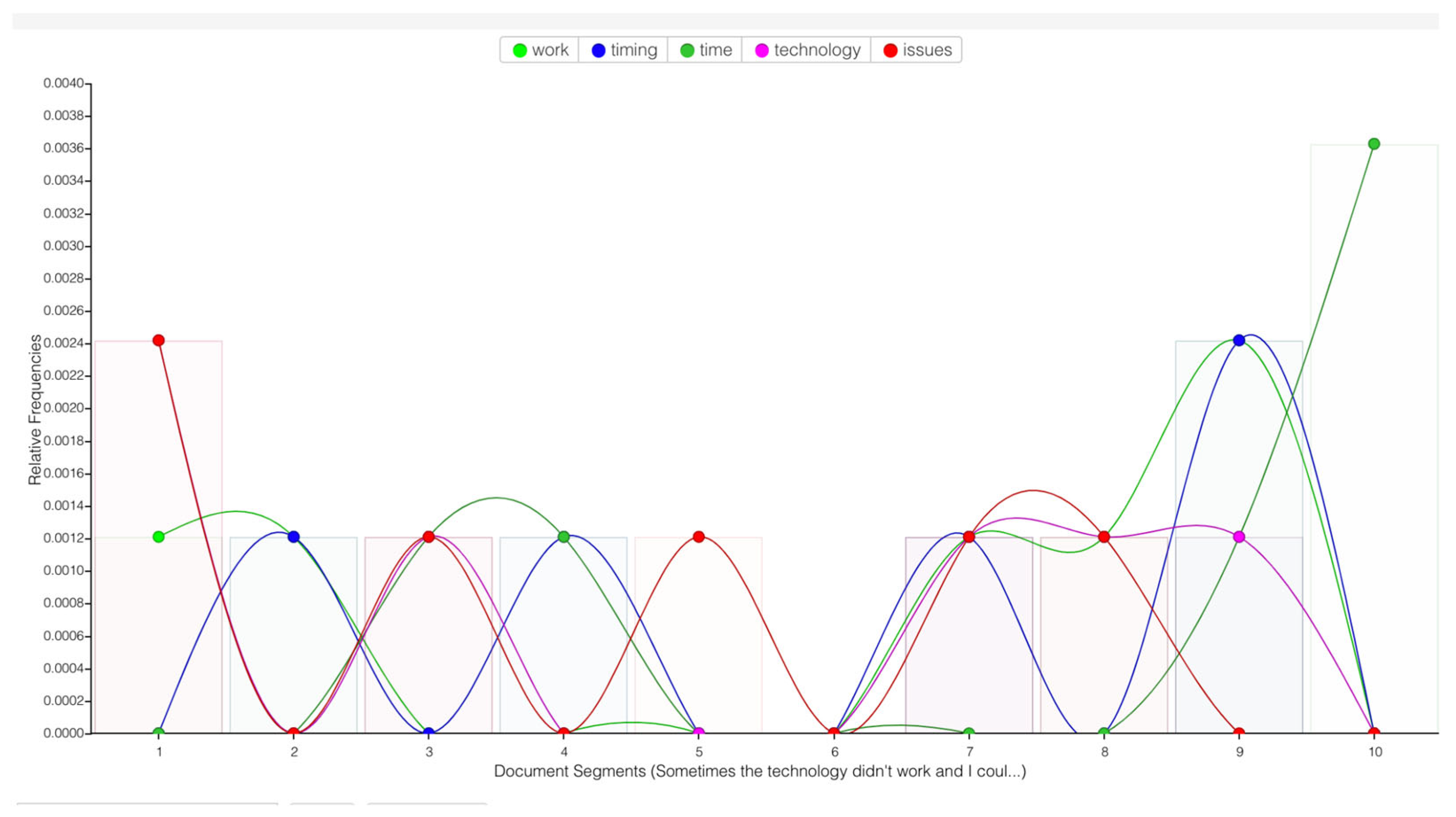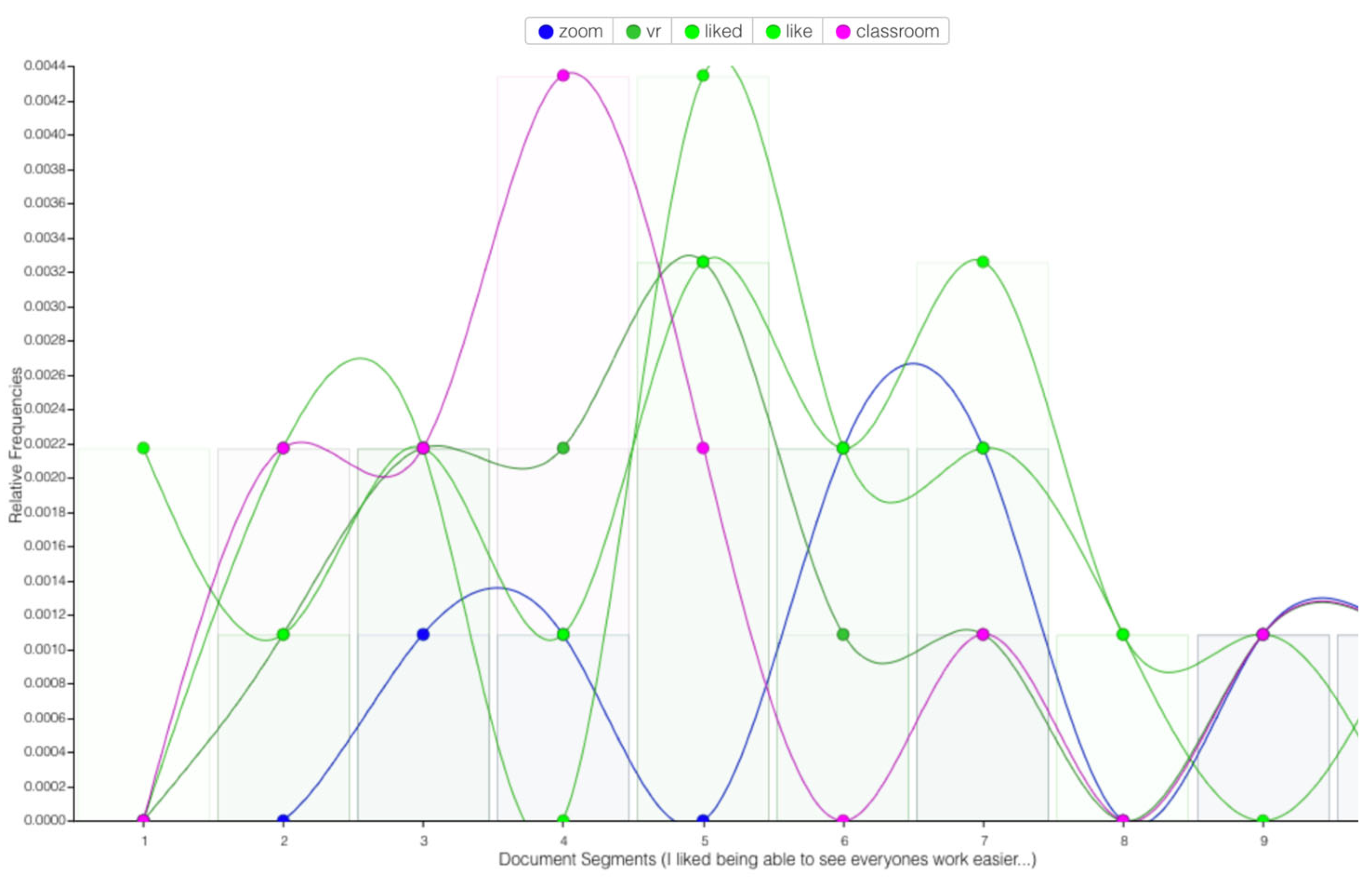Adding a Web-Based Virtual Reality Classroom Experience to a Hybrid, Blended Course Modality
Abstract
:1. Introduction
2. Materials and Methods
- I think that I would like to use this VR classroom frequently.
- I found the VR classroom unnecessarily complex.
- I thought the VR Classroom was easy to use.
- I think that I would need the support of a technical person to be able to use this VR Classroom.
- I found the various functions in this VR classroom were well integrated.
- I thought there was too much inconsistency in this VR Classroom.
- I would imagine that most people would learn to use this VR Classroom very quickly.
- I found the VR classroom very cumbersome to use.
- I felt very confident using the VR Classroom.
- I needed to learn a lot of things before I could get going with this VR Classroom.
- Add the total score for all odd-numbered questions and subtract 5 from the total to obtain (X).
- Add the total score for all even-numbered questions and subtract that total from 25 to obtain (Y).
- Add up the total score of the new values (X + Y) and multiply by 2.5.
3. Results
3.1. Findings from Qualitative Data
3.2. Findings from Quantitative System Usability Scale (SUS) Data
4. Discussion
- Turn off positional audio during presentations and turn it back on for breaking into groups.
- Have a very clearly defined use and reason for meeting in the VR space.
- Removing unnecessary objects to reduce loading issues for mobile participants.
- Take advantage of the media frames feature for screen-sharing presentations.
- Using the objects menu to streamline the viewing of presentations from various points in the room.
- Keep meetings short to avoid lag and the need to refresh the browser.
- Having a separate viewing room for posted recordings or PDFs and an interaction room for meetings in order to limit load when joining as a group.
5. Conclusions
Funding
Institutional Review Board Statement
Informed Consent Statement
Data Availability Statement
Conflicts of Interest
References
- Azar, A.; Farahat, Z.; Benslimane, O.; Megdiche, K.; Ngote, N.; Samir, J. Implementation of a Virtual Reality Operating Room for Simulation Purposes in Medical Training. In Proceedings of the 2020 International Conference on Electrical and Information Technologies (ICEIT), Rabat, Morocco, 4–7 March 2020; IEEE: Piscataway, NJ, USA, 2020; pp. 1–6. [Google Scholar]
- Roman, T.A.; Racek, J. Virtual reality as a pedagogical tool to design for social impact: A design case. TechTrends 2019, 63, 79–86. [Google Scholar] [CrossRef]
- Jin, L.; Wen, Z.; Gough, N. Social virtual worlds for technology-enhanced learning on an augmented learning platform. Learn. Media Technol. 2010, 35, 139–153. [Google Scholar] [CrossRef]
- Chang, X.; Zhang, D.; Jin, X. Application of virtual reality technology in distance learning. Int. J. Emerg. Technol. Learn. (Online) 2016, 11, 76. [Google Scholar] [CrossRef]
- Williams, S.; Enatsky, R.; Gillcash, H.; Murphy, J.J.; Gračanin, D. Immersive technology in the public school classroom: When a class meets. In Proceedings of the 2021 7th International Conference of the Immersive Learning Research Network (iLRN), Eureka, CA, USA, 17 May–10 June 2021; IEEE: Piscataway, NJ, USA, 2021; pp. 1–8. [Google Scholar]
- Pellas, N.; Mystakidis, S.; Christopoulos, A. A Systematic Literature Review on the User Experience Design for Game-Based Interventions via 3D Virtual Worlds in K-12 Education. Multimodal Technol. Interact. 2021, 5, 28. [Google Scholar] [CrossRef]
- Canniff, K.; Cliburn, D.C. Teaching Virtual Reality in Virtual Reality. In Proceedings of the 2022 8th International Conference of the Immersive Learning Research Network (iLRN), Vienna, Austria, 30 May–4 June 2022; IEEE: Piscataway, NJ, USA, 2022; pp. 1–8. [Google Scholar]
- Eriksson, T. Failure and success in using mozilla hubs for online teaching in a movie production course. In Proceedings of the 2021 7th International Conference of the Immersive Learning Research Network (iLRN), Eureka, CA, USA, 17 May–10 June 2021; IEEE: Piscataway, NJ, USA, 2021; pp. 1–8. [Google Scholar]
- Yoshimura, A.; Borst, C.W. Evaluation and comparison of desktop viewing and headset viewing of remote lectures in vr with mozilla hubs. In Proceedings of the International Conference on Artificial Reality and Telexistence, and Eurographics Symposium on Virtual Environments (ICAT-EGVE), Virtual, 2–4 December 2020. [Google Scholar]
- Mystakidis, S.; Berki, E.; Valtanen, J.P. Deep and meaningful e-learning with social virtual reality environments in higher education: A systematic literature review. Appl. Sci. 2021, 11, 2412. [Google Scholar] [CrossRef]
- Huisinga, L. Virtual Exhibit Design: The UX of Student BFA Design Shows in Social VR. In International Conference on Applied Human Factors and Ergonomics; Springer: Cham, Switzerland, 2021; pp. 240–246. [Google Scholar]
- Schwaiger, M. (Ed.) Boosting Virtual Reality in Learning; Focus Europe: Graz, Austria, 2020. [Google Scholar]
- Genz, F.; Fuchs, N.; Kolb, D.; Müller, S.; Kranzlmüller, D. Evaluation of Proprietary Social VR Platforms for Use in Distance Learning. In Proceedings of the Augmented Reality, Virtual Reality, and Computer Graphics: 8th International Conference, AVR 2021, Virtual Event, 7–10 September 2021; Springer International Publishing: Berlin/Heidelberg, Germany, 2021; pp. 462–480. [Google Scholar]
- Huisinga, L.A. User Experience of Social Web-Based Virtual Reality for the Hybrid and Blended Learning Classroom. Hum. Side Serv. Eng. 2022, 62, 55. [Google Scholar]
- Schouten, A.P.; van den Hooff, B.; Feldberg, F. Virtual Team Work: Group Decision Making in 3D Virtual Environments. Commun. Res. 2016, 43, 180–210. [Google Scholar] [CrossRef]
- Downey, S.; Mohler, J.; Morris, J.; Sanchez, R. Learner perceptions and recall of small group discussions within 2D and 3D collaborative environments. Australas. J. Educ. Technol. 2012, 28, 28. [Google Scholar] [CrossRef] [Green Version]
- Scavarelli, A.; Arya, A.; Teather, R.J. Towards a framework on accessible and social VR in education. In Proceedings of the 2019 IEEE Conference on Virtual Reality and 3D User Interfaces (VR), Osaka, Japan, 23–27 March 2019; IEEE: Piscataway, NJ, USA, 2019; pp. 1148–1149. [Google Scholar]
- Çoban, M.; GOKSU, İ. Using virtual reality learning environments to motivate and socialize undergraduates in distance learning. Particip. Educ. Res. 2022, 9, 199–218. [Google Scholar] [CrossRef]
- Hodge, E.M.; Tabrizi MH, N.; Farwell, M.A.; Wuensch, K.L. Virtual reality classrooms: Strategies for creating a social presence. Int. J. Soc. Sci. 2008, 2, 105–109. [Google Scholar]
- Mystakidis, S.; Berki, E.; Valtanen, J. Toward successfully integrating mini learning games into social virtual reality environments: Recommendations for improving open and distance learning. In EDULEARN Proceedings; IATED Academy: València, Spain, 2017. [Google Scholar]
- Merchant, Z.; Goetz, E.T.; Cifuentes, L.; Keeney-Kennicutt, W.; Davis, T.J. Effectiveness of virtual reality-based instruction on students’ learning outcomes in K-12 and higher education: A meta-analysis. Comput. Educ. 2014, 70, 29–40. [Google Scholar] [CrossRef]
- Brooke, J. SUS-A quick and dirty usability scale. Usability Eval. Ind. 1996, 189, 4–7. [Google Scholar]
- Smyk, A.; Herman, L.; Silveira, D.; Babich, N.; Kingston, C. The System Usability Scale & How It’s Used in UX: Adobe XD Ideas. Available online: https://xd.adobe.com/ideas/process/user-testing/sus-system-usability-scale-ux/ (accessed on 20 December 2022).
- Sinclair, S.; Rockwell, G. Trends. Voyant Tools. 2023. Available online: https://voyant-tools.org/?query=work&query=time&query=technology&query=issues&query=timing&mode=document&corpus=de37481557034c9cfaa4f86f00d582a4&view=Trends (accessed on 17 January 2023).
- Sinclair, S.; Rockwell, G. Trends. Voyant Tools. 2023. Available online: https://voyant-tools.org/?query=liked&query=like&query=classroom&query=vr&query=zoom&mode=document&corpus=2b209a7e61dd11c16f6266fbc1749dba&view=Trends (accessed on 17 January 2023).
- McMurtrie, B. A ‘Stunning’ Level of Student Disconnection. 2022. Available online: https://www.chronicle.com/article/a-stunning-level-of-student-disconnection (accessed on 17 January 2023).




Disclaimer/Publisher’s Note: The statements, opinions and data contained in all publications are solely those of the individual author(s) and contributor(s) and not of MDPI and/or the editor(s). MDPI and/or the editor(s) disclaim responsibility for any injury to people or property resulting from any ideas, methods, instructions or products referred to in the content. |
© 2023 by the author. Licensee MDPI, Basel, Switzerland. This article is an open access article distributed under the terms and conditions of the Creative Commons Attribution (CC BY) license (https://creativecommons.org/licenses/by/4.0/).
Share and Cite
Huisinga, L. Adding a Web-Based Virtual Reality Classroom Experience to a Hybrid, Blended Course Modality. Virtual Worlds 2023, 2, 231-242. https://doi.org/10.3390/virtualworlds2030014
Huisinga L. Adding a Web-Based Virtual Reality Classroom Experience to a Hybrid, Blended Course Modality. Virtual Worlds. 2023; 2(3):231-242. https://doi.org/10.3390/virtualworlds2030014
Chicago/Turabian StyleHuisinga, Laura. 2023. "Adding a Web-Based Virtual Reality Classroom Experience to a Hybrid, Blended Course Modality" Virtual Worlds 2, no. 3: 231-242. https://doi.org/10.3390/virtualworlds2030014
APA StyleHuisinga, L. (2023). Adding a Web-Based Virtual Reality Classroom Experience to a Hybrid, Blended Course Modality. Virtual Worlds, 2(3), 231-242. https://doi.org/10.3390/virtualworlds2030014





